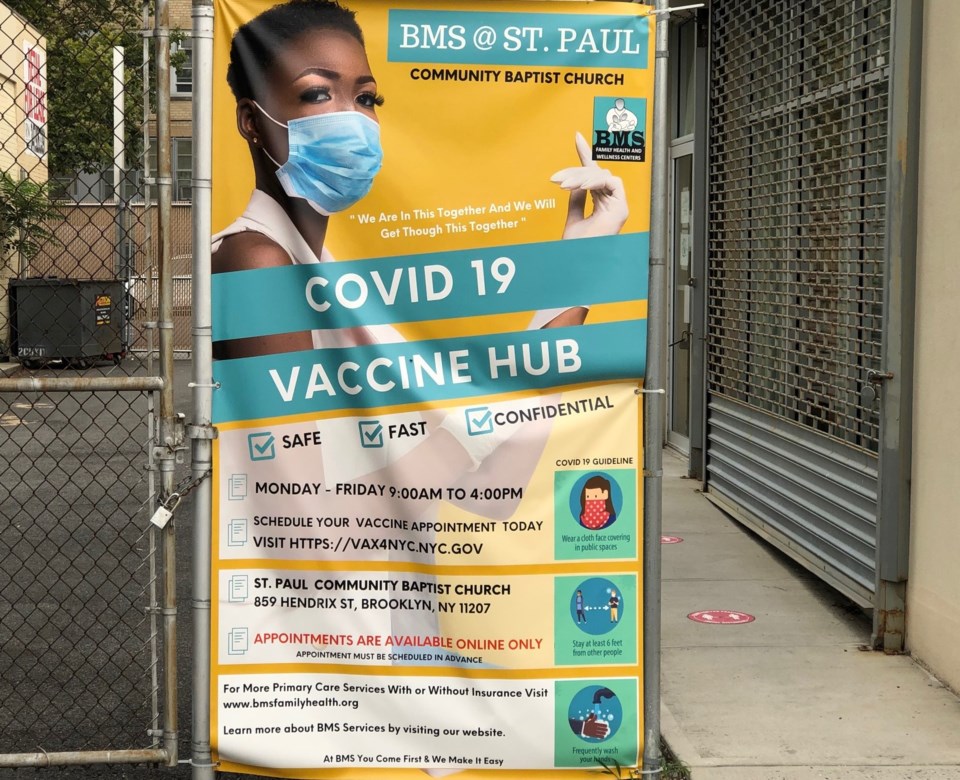Many people thought we were out of the woods. But the COVID-19 infection rate is going in the wrong direction.
On Tuesday, Mayor Bill de Blasio said NYC will require customers to show proof of vaccination to participate in indoor activities. Along with $100 payments, it was one of the latest attempts to coax unvaccinated New Yorkers to get inoculated.
An estimated 66% of adults are fully vaccinated, according to city data. However, the rate is much lower in some pockets, an indication that there's much work ahead.
Brooklynites living in ZIP code 11201 have one of the highest vaccination rates. Nearly 74 % of residents in the Brooklyn Heights area are fully vaccinated. And in ZIP code 11215, the Park Slope and Gowanus area, 65% of residents are fully vaccinated.
In contrast, the vaccination rates in ZIP code 11212 (Brownsville/Ocean Hill) and 11207 (East New York/Cypress Hill) are much lower. About 38% of people in the Brownsville area are fully vaccinated, and the rate is 39% in East New York.
The reasons for the low vaccination rates are layered. They range from misinformation online and widespread conspiracy theories to access issues.
Lack of appointments or access
"I wanted to get the shot earlier, but I couldn't get an appointment and didn't know what to do," Brownsville resident Margarita Cortes told BK Reader. "So, I just put it off."
It was indeed a challenge for many East New Yorkers and Brownsville residents to get shots when vaccines became available.
"At first, not everyone served was from the community," Renee Muir, director of development and community relations at BMS Family Health and Wellness Centers, told BK Reader.
BMS offers vaccines in partnership with community-based organizations and the NYC Department of Health and Mental Hygiene.
In April, the health care center, which is based in Brownsville, started administering COVID-19 shots at a facility on Hendrix Avenue in East New York.
"When we first opened, a lot of the folks who were coming through were not from the community because we were part of this giant pool [of health care facilities], and it was a race to get an appointment anywhere for highly motivated people," Muir recalled.
BMS advocated successfully with state officials to allow them to set aside appointments that only they would schedule to make sure there was always space for local residents, Muir explained. Eventually, officials allowed the facility to become a fully walk-in site.
Concerns with development
LaShonda White, an East New York resident, said she delayed getting the vaccine mainly because she's a young adult without underlying conditions.
"When things started opening back up and people stopped wearing masks, I just didn't see the need to get the vaccine," she told BK Reader.
"Anyway, I have some concerns about how fast they came up with this vaccine," she added.
Muir said safety concerns and conspiracy theories on social media are among the biggest obstacles to increasing the vaccination rate in some neighborhoods.
"You have to walk them through exactly why the vaccine made it to the market so quickly and the fact that there were Black and brown folks on the National Institutes of Health advisory committee overseeing the vaccine development," she said.
The center was finally able to ramp up its vaccine education efforts several weeks ago when officials lifted the mask-wearing mandate for vaccinated people.
"What really is going to move this is just having people go out and canvas and talk to folks face-to-face," she said. "We have to hear what their concerns are and give them information."
A BMS survey found some other factors that contributed to the low vaccination rate.
"There's a surprisingly large, unexpected personal belief group who are faith-based who feel that their faith will protect them," Muir noted.
She also pointed to a "transportation barrier." Many low-income families can't afford the round-trip metro fares for every family member.
That's one of the reasons BMS added a pop-up model that takes the vaccines to where people live while also offers them other services, including a food pantry.
"We have to meet people where they are," Muir emphasized.




